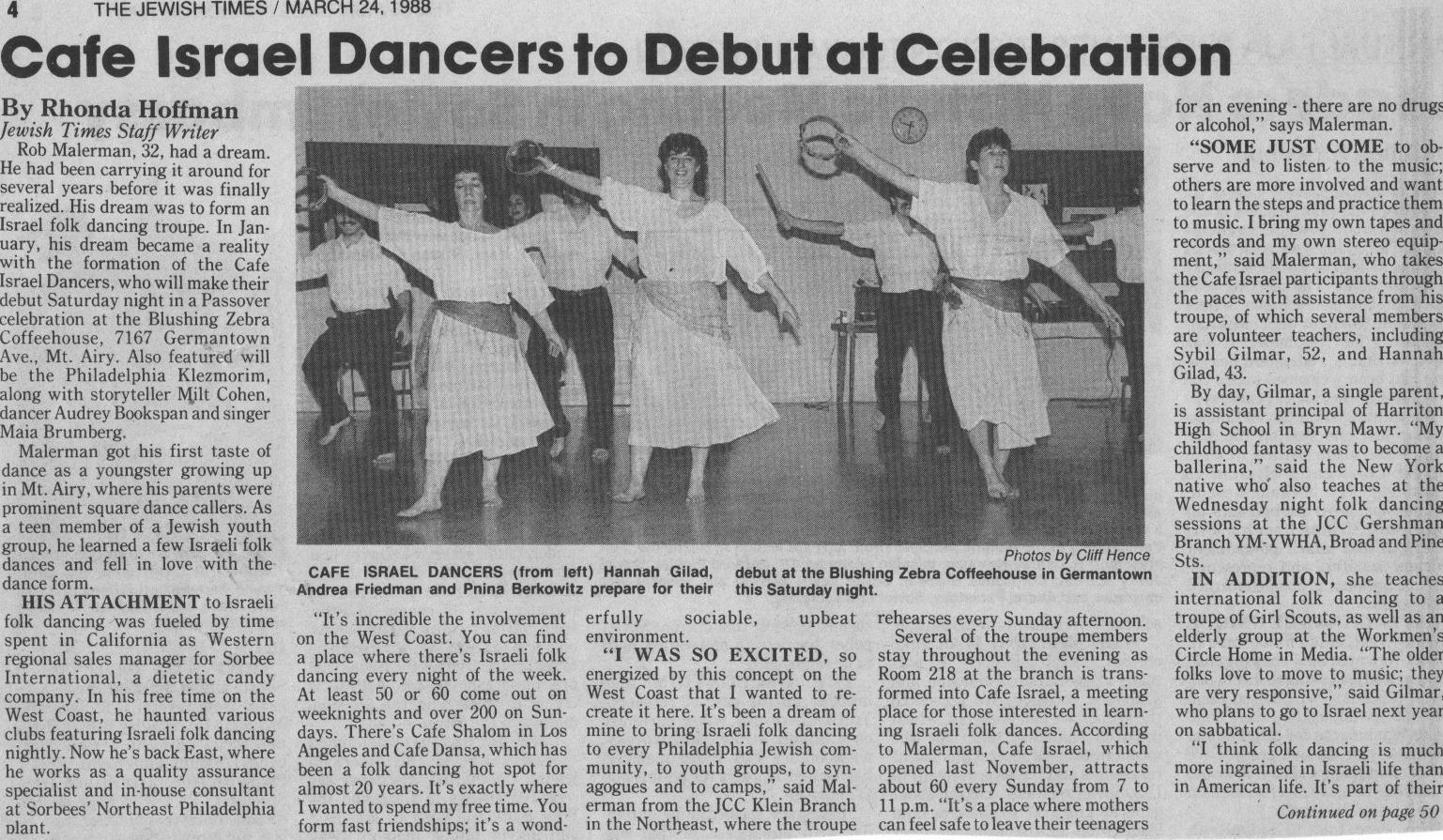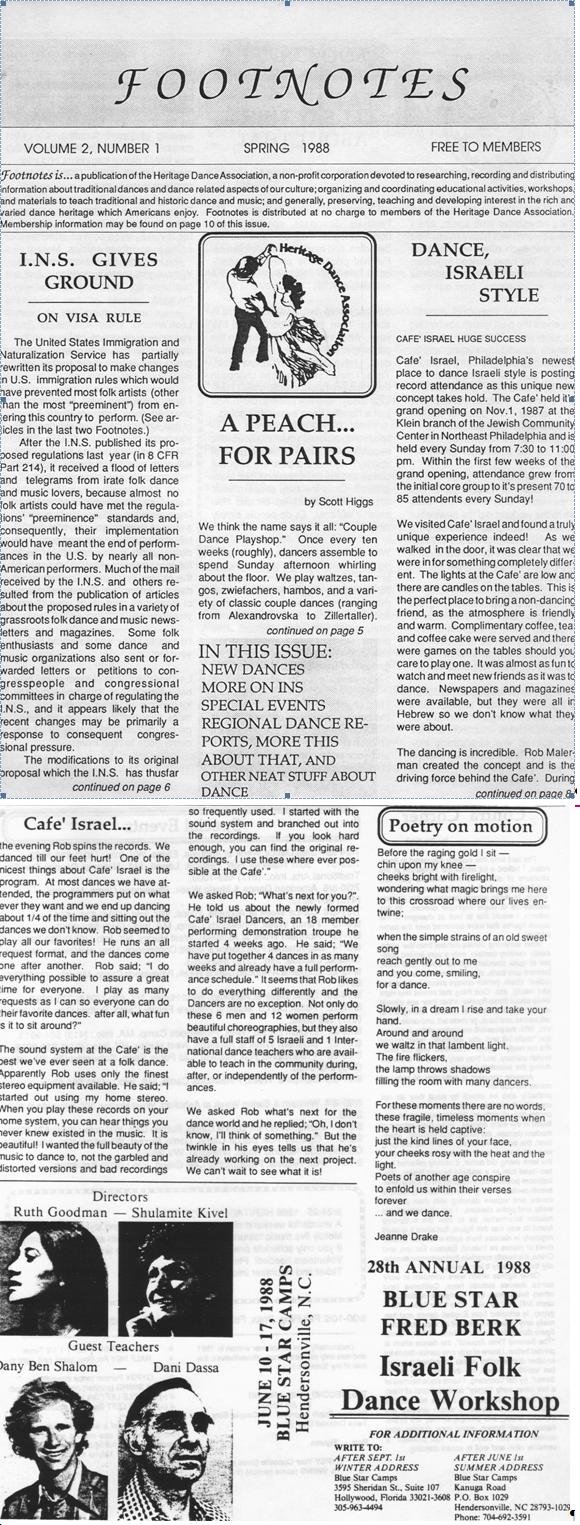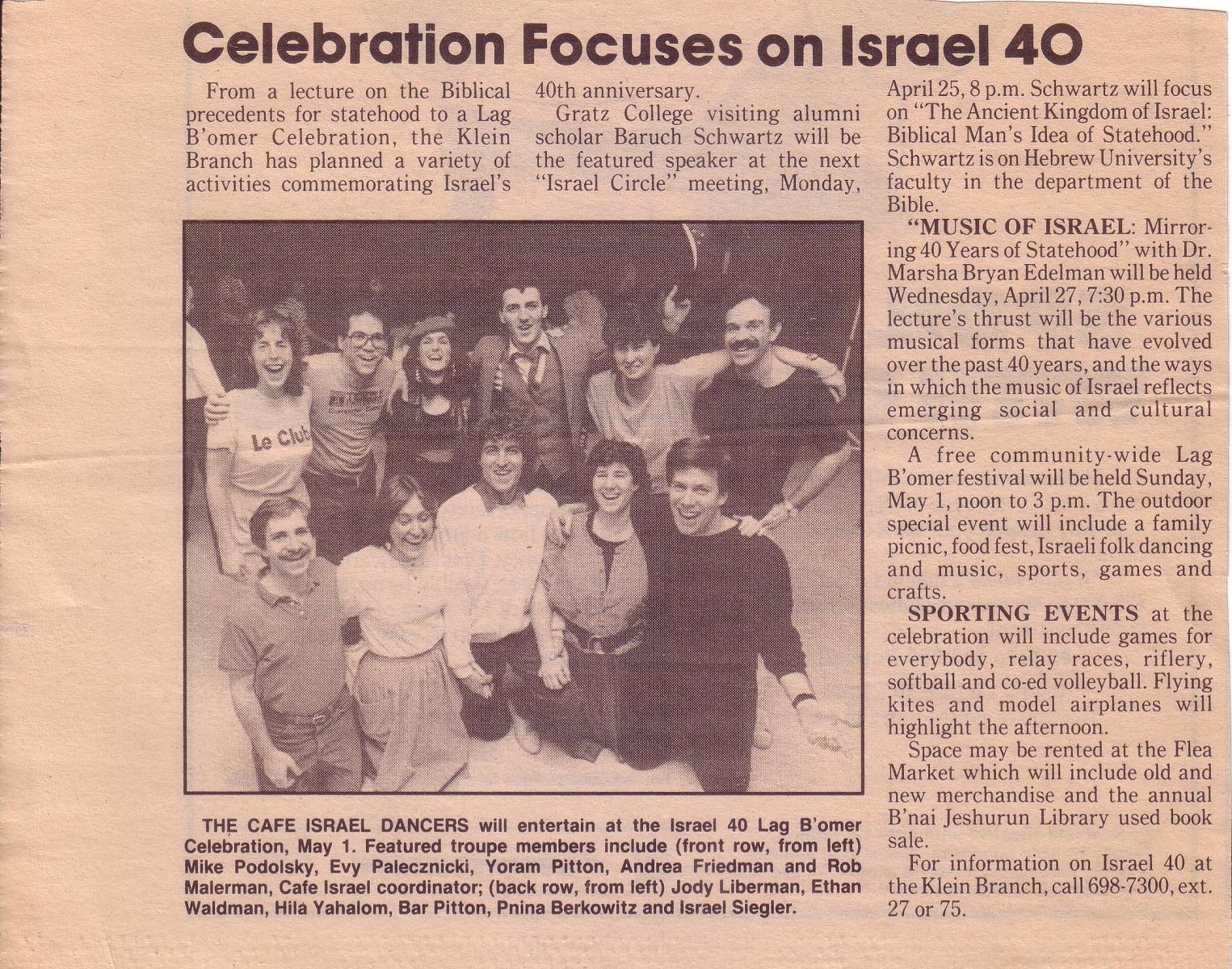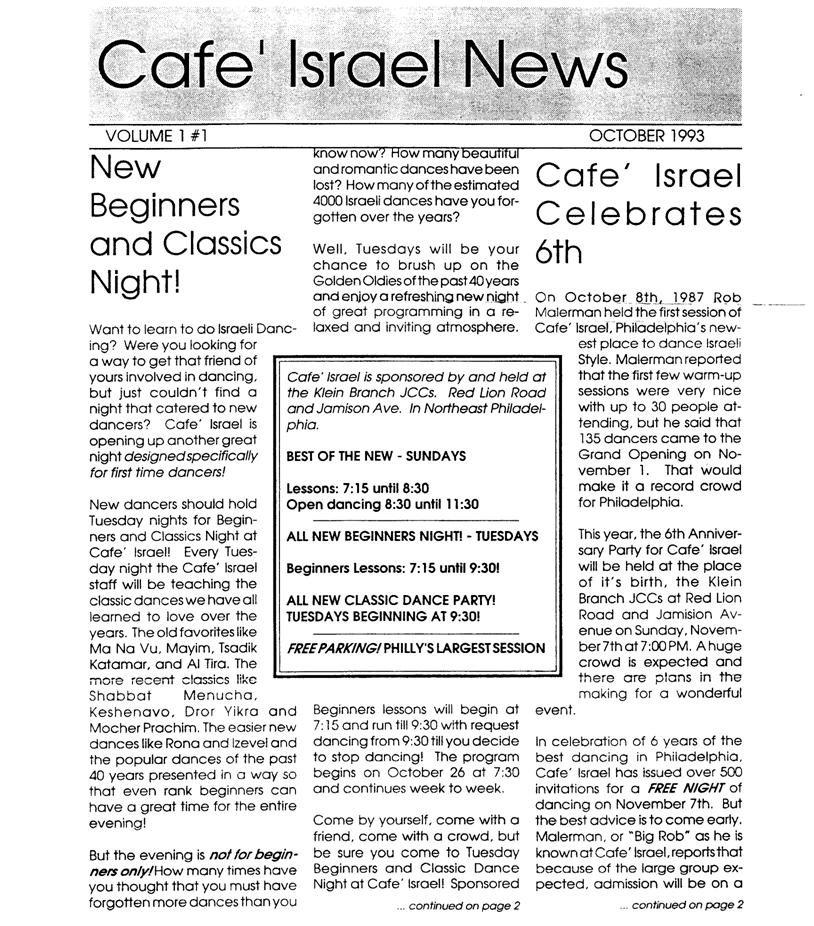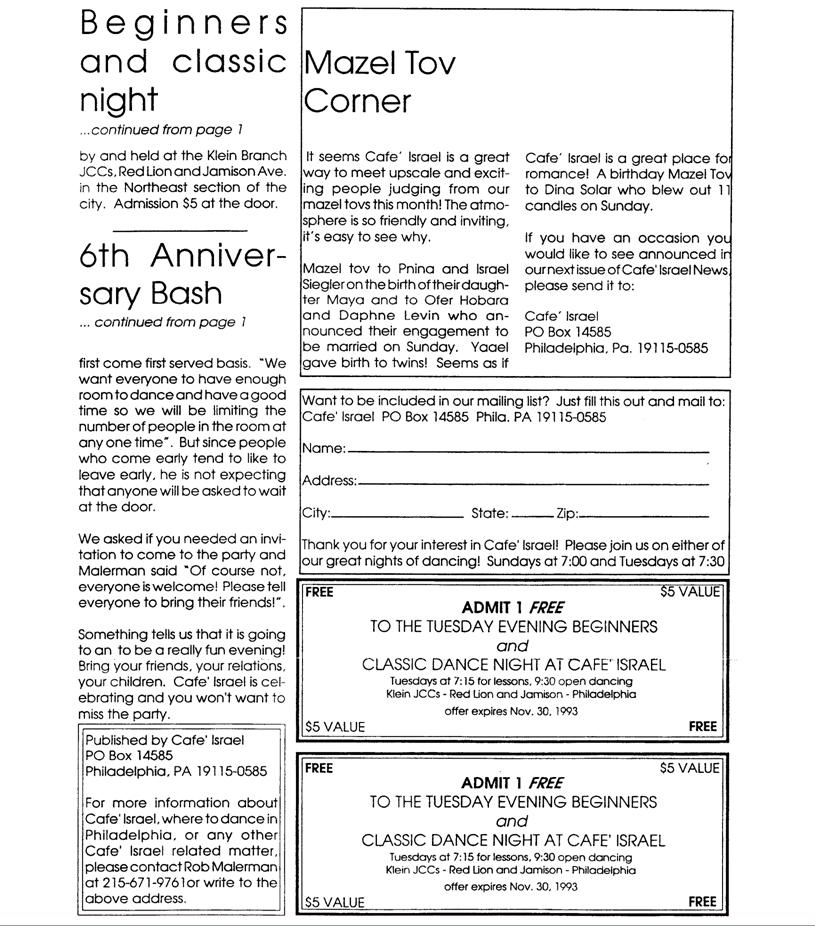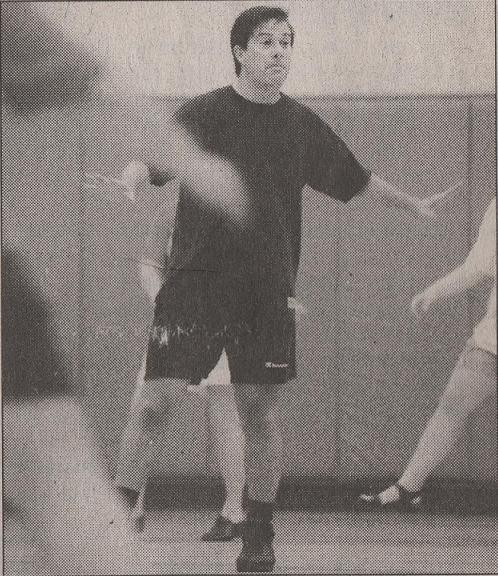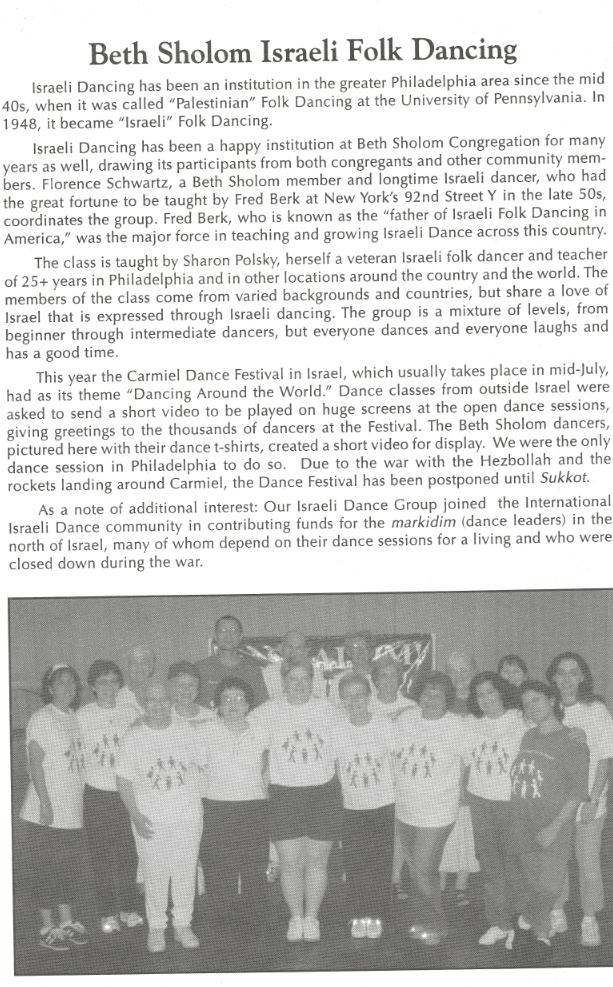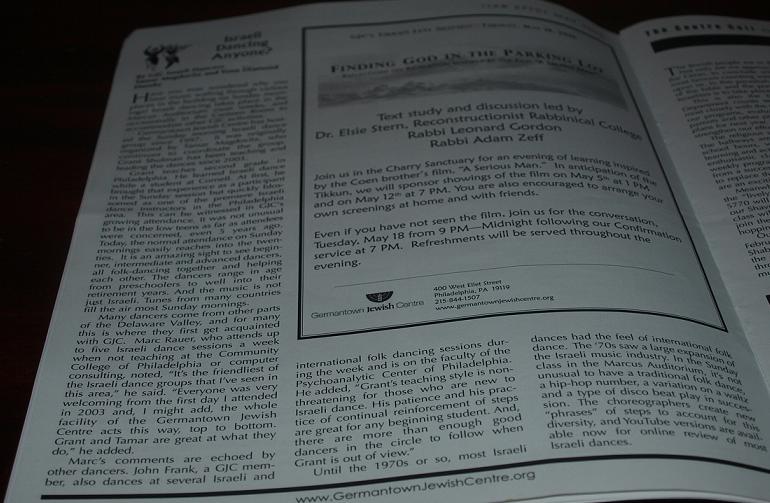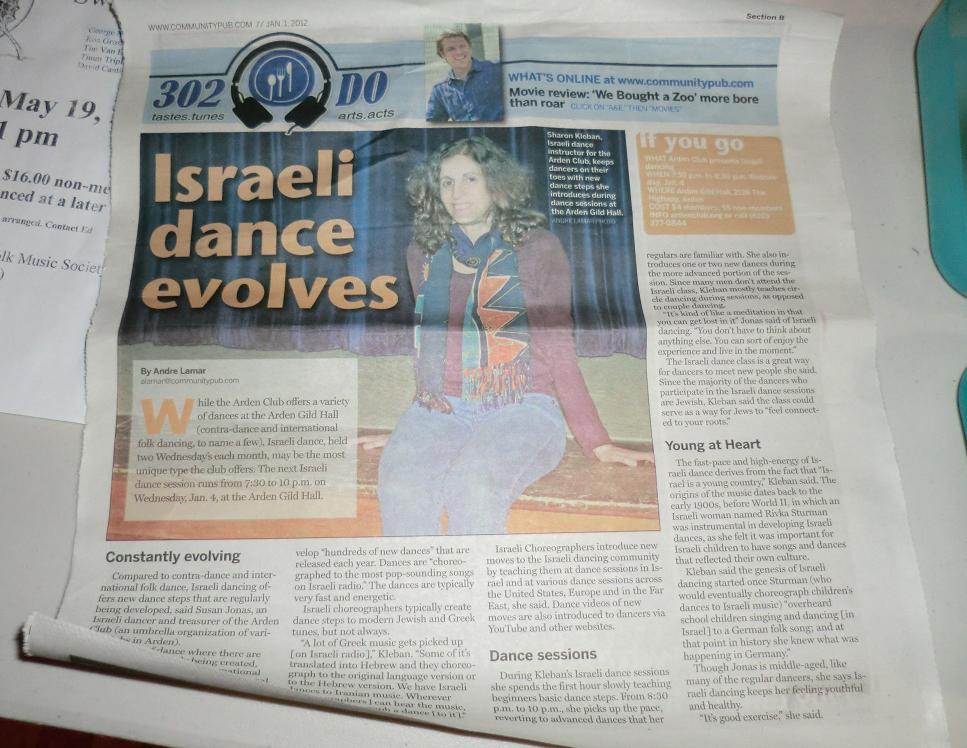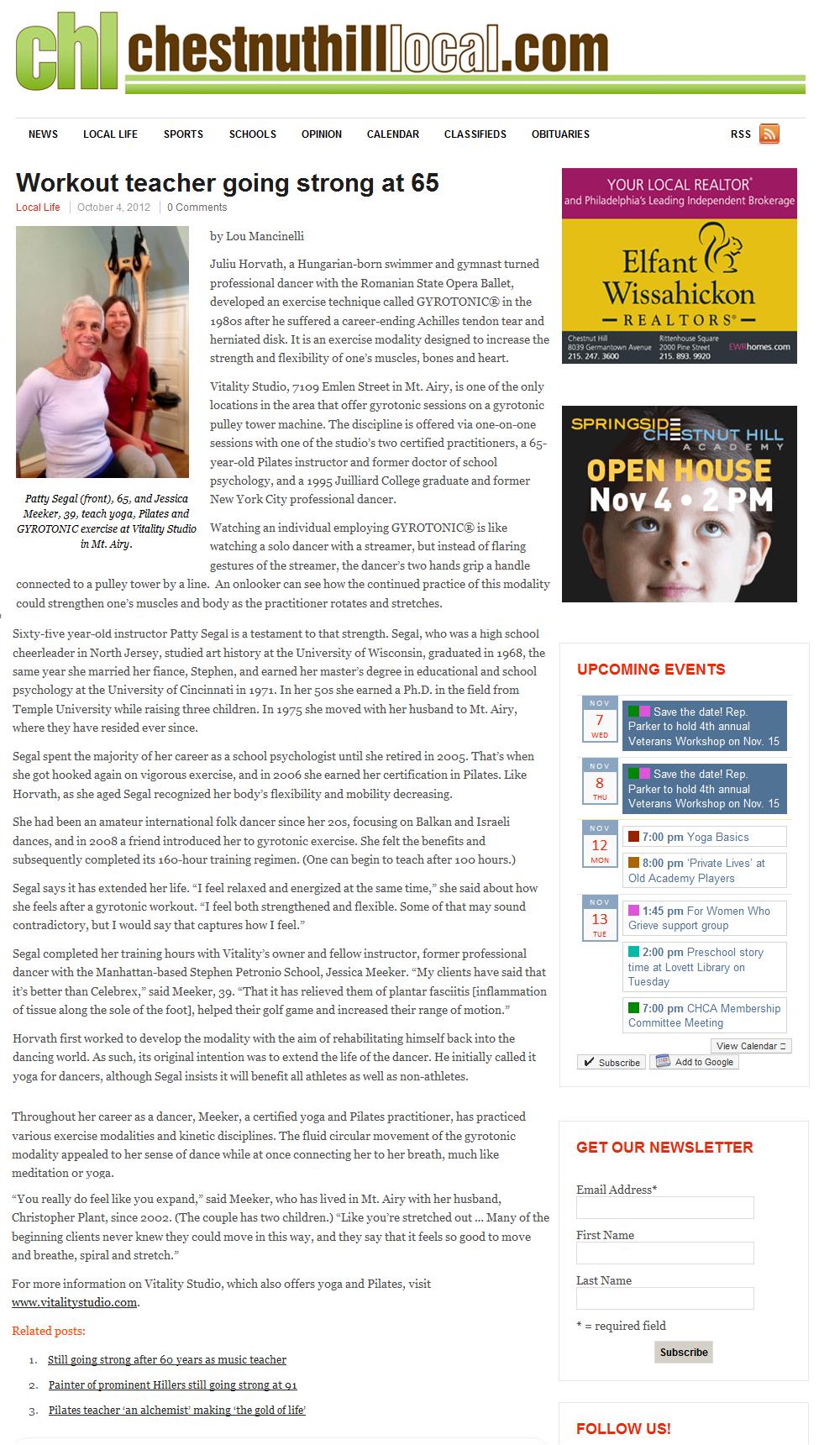|
Used to be, Wednesday nights at the Jewish Community Center’s Gershman YM-YWHA Branch, Broad and Pine Sts, in center city Phila, was the place. And, if 60 people showed up, it was a good night. These days, aficionados of Israeli folk dancing can dance 4 nights a week at five different locations throughout the city and suburbs. And, on a good night, two of these locations will attract 100-plus dancers
“It’s a good way to be involved with the Jewish community, do aerobic dancing – which happens to be Israeli dancing –and meet people,” said Carol Kahn, program director at the Gershman Y, still one of the mainstays of the local Israeli dance scene.
According to Ed Frim, who has been dancing regularly in Philadelphia for the past 10 years, “what kept Israeli dancing going in Philadelphia for the past seven years was this group of volunteers that kept it (the folk dance program) running at the Gershman Y. This relatively small group of eight to ten people very devotedly and harmoniously did all the work to keep everything going – programming, teaching, collecting the money, maintaining the mailing list.
“Everyone has his or her job. It was a labor of love for them,” added Frim, director of special projects at the Central Agency for Jewish Education and a member of the Israeli Folk Dance Committee at the Gershman Y for the past three years.
Israeli folk dancing in Philadelphia actually didn’t start out at the Gershman Y. In 1947, the Penn Hillel Palestianian Dance Group was formed on the campus of the University Of Pennsylvania. The following year, when the State of Israel was established, the group changed its name to Penn Israeli dance group.The group has been meeting Wednesday nights to dance ever since, having relocated to the Gershman Y in 1985.
While Frim is glad Israeli Folk dancing has blossomed in Philadelphia, he still prefers dancing at the Gershman Y. “Downtown offers more of a standard repertoire,” he explained. “Not only are we interested in doing the disco or latest Israeli dances, but we do the old dances as well.”
According to Frim, The Gershman Y also is an ideal place to learn dances. A beginner’s class, taught by Sherry Milner, is held Wednesday, 6:30 to 7PM; an advanced beginners/intermediate class, also taught by Milner, 7 to 7:45pm; and an immediate/advanced class, taught by various members of the committee, 7:45 to 8:30 PM, followed by open request dancing to 10:45PM.
“A lot of my dancing is teaching related,” said Milner, who also conducts Israeli folk dance workshops for synagogues, Hebrew schools, and other organizations. Having been involved with Israeli folk dancing for the past seven years, Milner also has many years of experience in International folk dancing “which has a smattering of Israeli in it” she explained. In fact, that’s how she got into Israeli folk dancing. “I got hooked very quickly,” Milner said. “The Jewish aspect hit home like no other nationality would,” she added. “Also, the variety makes it appealing.
Israeli Folk Dancing is the only nationality that has an international flavor; it’s the only one that was not allowed to evolve naturally. Because of the Diaspora, it got dispersed,” Milner explained. “When people came back(to the land of Israel), they brought the flavor of where they had come with them. Then, at statehood, it was created as Israeli folk dance.”
While Milner teaches all levels of Israeli folk dance, she said there is a certain draw to teaching beginners. “I got turned on seeing people turned on to Israeli dance,” she said. “Exposing them to it and helping them see how terrific and exciting it can be, that charges me up.”
Hannah Weil, who teaches Israeli Folk dance Tuesdays 7 to 10PM, at Gratz College on the Mandell Education Campus in Melrose Park, said she dances because, “it’s exciting, good exercise and a good social activity.”
Weil, who has been dancing steadily for 23 years, mostly in Israel, where she lived for 24 years, said she teaches Israeli folk dance “because it’s part of our heritage. I believe in perpetuating the real cultural heritage of Israel.”
She added that she tries to teach a mixture of dances and doesn’t classify a dance as an Israeli folk dance unless it’s been danced for at least 30 years. “The problem is, Israel is such a young country,” she reflected.
Much of the Israeli dancing done in Philadelphia Weil calls Israeli dance, rather than folk dance. “Israeli dances are more choreographed, and the music is more modern,” she explained, “whereas folk dancing consists of one or two steps repeated over and over.”
Danny Uziel, an Israeli-born9 choreographer/teacher who now lives in New York City, where he designs jewelry, pointed out that today, Israeli dancing has caught on all over the world. Folk dance groups in Europe, China, Japan and even the Soviet Union have included Israeli dance in their repertoires, he told the Jewish Times while visiting Philadelphia earlier this month to teach at a Yom Ha’atzmaut dance party on Boathouse row.
Uziel, who has been choreographing and teaching the past 40 years, has noticed a big difference between the 60’s and 90’s in terms of Israeli folk dance participation. In the 90’s, he said, dancing has become more of a social activity both in the US and Israel. “There are more dancers, more choreographers – which has created a happy environment,” he said. “But, the bottom line is, it’s beautiful.”
His advice to the novice:”Every beginning is hard, but once you know it, you enjoy it. It’s like learning a language. The more you dance, the better you are. Learn the movement and the steps then forget about them and enjoy.”
Sharon Polsky, of Northeast Philadelphia, said Uziel “smiles the whole time (he’s dancing).” Polsky, who has been dancing the past 14 years, is one of the committee members who has kept Israeli folk dancing going at the Gershman Y. “The committee worked great because we were all friends,” she explained. Uziel agreed that the Israeli folk dancing group in Philadelphia is more cohesive than those in other cities.
“Most of my friends are from dancing,” Polsky remarked, adding that she’s met people from all across the country and all over the world by attending weekend Israeli folk dance workshops. “I can go anywhere in the US, England or Paris and know somebody and fit right in,” she said. “And dancing provides me with a real connection to Israel.”
Israeli dancing provided Steve and Janet Schwartz with a different type of connection: That’s how the couple met, no less than three times. Steve Schwartz said he doesn’t remember the first time. The second time, they dated for a while and then stopped until the third time they met dancing.
That was 10 years ago. Married now for three and a half years, they are the proud parents of 3 month old Rachel, who already is being introduced to Israeli dancing.
Steve Schwartz, a certified public accountant and computer consultant – he maintained the mailing list while a member of the Israeli Folk Dancing committee at the Gershman Y – started dancing 13 years ago while a volunteer with the American Zionist Youth Foundation’s Sherut La’em (service to the people) program in Dimona, a development town in the Negev.
“There’s not a whole lot to do there except folk dance,” he explained. Schwartz’ first teacher was Moti Alfassi, now a well known choreographer. When Schwartz returned to the University of Pennsylvania as a graduate student, he discovered that he knew more dances than the people who had been dancing at Penn Hillel for years.
“Dancing is a good Jewish activity,“ he said. It used to be a good singles event. And now that I’m married, since my wife’s a dancer, we enjoy dancing together. It reminds me of the good times I had in Israel.”
Beginning June 10, Schwartz, who feels that there’s room in Philadelphia for more variety on the Israeli dance scene, will teach a beginner’s class at the JCCs’ Kaiserman Branch, City line Ave and Haverford, Mondays 7 to 8PM, followed by open dancing until 10PM. He’s calling it “classic Israeli folk dancing – the oldies and goodies.”
Rob Malerman felt the Philadelphia Israeli folk dance community needed something new when he started Café Israel three years ago at the JCCs’ Klein Branch, Red Lion Rd and Jamison Ave, in the Northeast. “I wanted to bring a little piece of California and Israel here to Philadelphia,” said Malerman, director of manufacturing for Sorbee, which makes sugar free candy.
At Café Israel, the lights are low, the room air-conditioned and the sound system excellent. Coffee and refreshments are served. All in all, it’s a “café like atmosphere and a real social environment,” he noted.
Malerman got an early start in folk dancing; his parents were among Philadelphia’s biggest square dance callers, and his Mother taught International Folk dancing while pregnant with him. He said he has memories of travelling from camp to camp with his parents.
As he grew up, Malerman took off on his own, becoming a song leader and an ad-hoc Israeli dance instructor with eastern PAFTY (Pennsylvania federation of Temple Youth). He danced extensively on the East Coast before going out to California five years ago and dancing at Café Danse in Los Angeles with Israeli dance choreographer Dani Dassa. “Café Israel is as close to California as we can make it, “ said Malerman. “The only thing we don’t have is Dani Dassa.
Beginning June 2nd, Malerman will teach a beginner’s class, 7 to 8PM. The class is a joint project with the Klein branch and B’nai B’rith Youth Organization (BBYO). It (BBYO) has kids, and kids and Israeli dancing go together.” Malerman remarked. Regarding beginning dancing, he said, “You have to train your feet to do what your brain is telling them to do.” From 8 to 8:30 PM, Reena Keren wil continue to teach the repertoire class Sundays at café Israel, followed by open request dancing.
“We do top 40 Israeli programming,” Malerman said, “as close as we can get. And, we do a lot of requests. Generally, what people want to hear are the most popular dances. And, we pay a lot of attention to what people want to hear.”
For Rob Markowitz, who’s been dancing for the past 16 years – ever since he was “forced” to take a beginners class as a member of a Zionist youth group – programming is the thing.
I enjoy having influence, putting on what people want to hear,” he said. Markowitz programs Sunday nights at Café Israel in the Northeast and Wednesday nights at the Gershman Y in center city. He also dances Tuesday nights at the Arthur Murray Dance Studio, 2417 Welsh Road, in the Northeast where Gabi Gabay teaches an advanced class beginning at 9:00 PM.
What keeps Markowitz dancing, he said, is the activity and interaction with people. He added, “Dancing is very addictive. It’s also a good singles scene, because it’s not billed as one. A lot of friendships are built around Israeli dancing.”
For those who want to try dancing, Markowitz said, “the key is to stick with it. You are going to make a fool of yourself for a while. Then one day, all the steps will fall into place, and you’ll feel fabulous.”
|
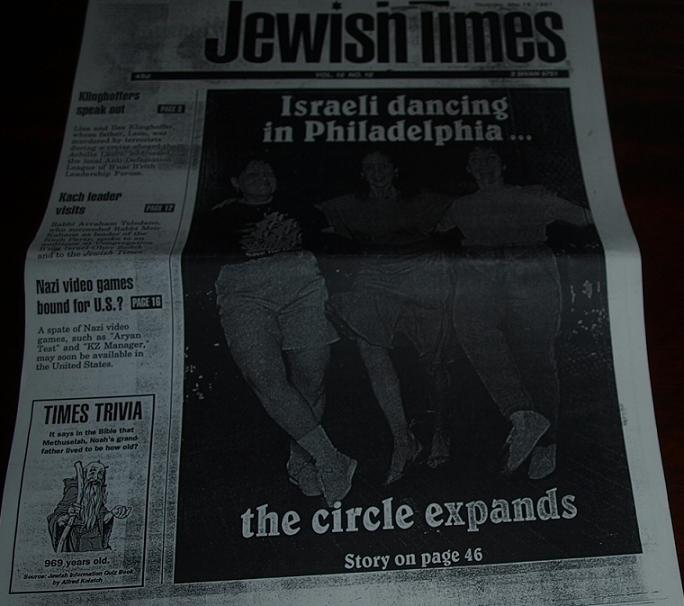 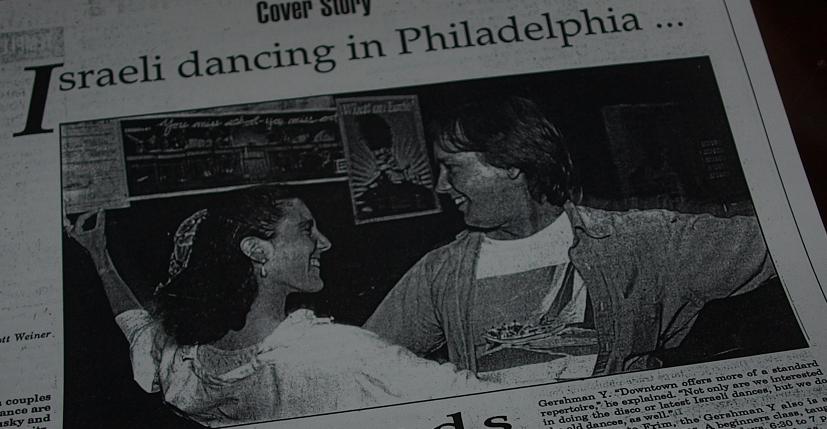 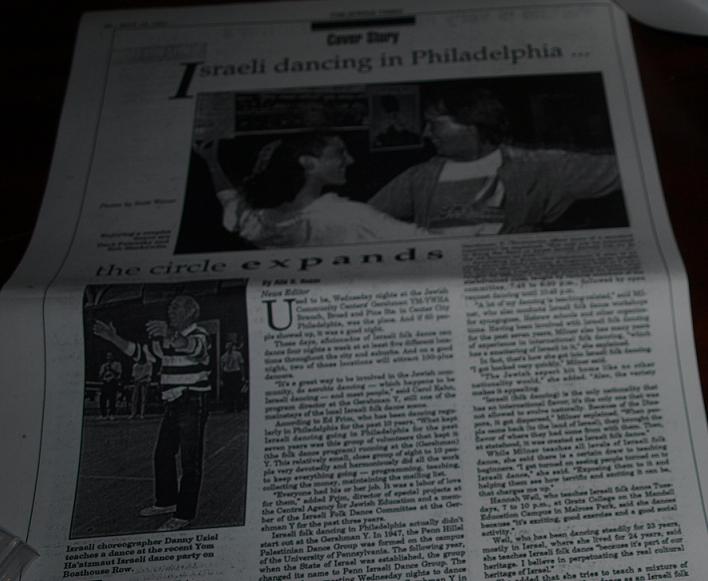 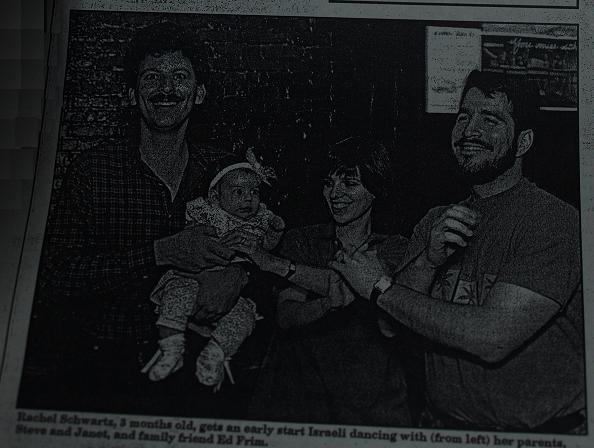 Where are they now This article mentions several people. We've tried to track down what they are doing now with some success - Sharon Polsky teaches Israeli dance at Beth Sholom on Tuesday nights. In addition, she supplied this and the article below to the disk coordinator and we thank her for this
- Janet and Steve Schwartz continue to do Israeli dance- Janet is a regular at the Thursday Adath Israel and Sunday Klein classes
- Rachel Schwartz has grown up since this article was written. Today she is a college student
- Danny Uziel can usually be seen at the Wednesday session at the 92nd street Y in New York where he sometimes teaches partner dancing
- There was a recent tribute to Rob Markowitz marking the end of his administration of the Sunday Klein branch session which he took over in 2000
- Rob Malerman's recent activities are documented above
- Ruth Goodman, who is only pictured, is the dean of Israeli dance instructors in the US. She runs the Monday and Wednesday sessions in New York
Within this article is the mention of the wedding of Janet and Steve Schwartz. Janet has been nice enough to provide a photograph of the wedding indicated below, and this picture apparently is of the couple dancing. This took place sometime in 1987 and Janet looks as lovely today as she does in the picture below.  In 1991, Israeli dancing could be done Sunday through Wednesday. The Jewish times article indicates - Cafe Israel at the Klein JCC on Sundays
- Kaiserman JCC on City Ave on Mondays
- Gratz College in Melrose park on Tuesdays, and
- Gershman Y on Wednesdays
|
